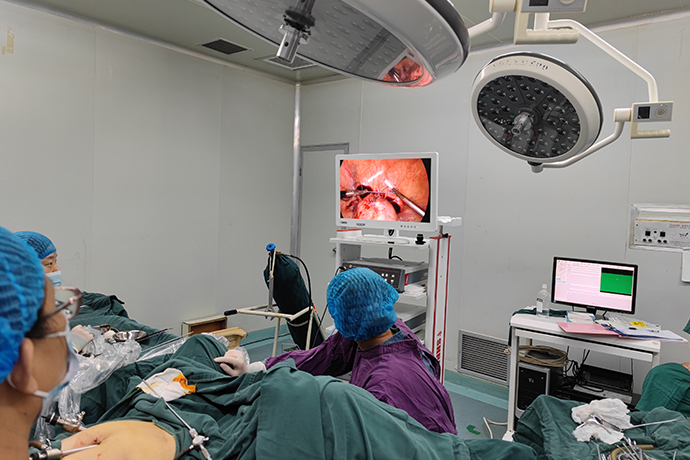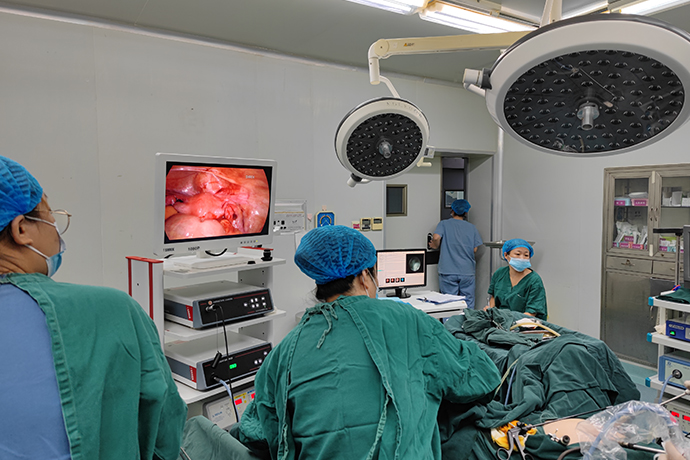【Gynecological Laparoscopy】Salpingostomy
Release time: 24 Aug 2021 Author:Shrek
1----Introduction
Fallopian tube obstruction is a common disease that leads to female infertility. Laparoscopy can be used to comprehensively observe the scope and extent of adhesions around the fallopian tubes and ovaries, understand whether the fallopian tubes are unobstructed, identify the obstruction site, and perform tubal plastic stoma surgery.

2----Indications
1. Patients with infertility, obstruction of the distal end of the fallopian tube, and water in the ampulla of the fallopian tube.
2. Fallopian tube-ovarian and pelvic adhesions.
3----Surgical steps and techniques
1. Take the bladder lithotomy position and insert the uterine tubal drainage tube through the vagina.
2. Understand the pelvic condition under laparoscopy
Lift up the affected fallopian tube with non-invasive forceps to separate the surrounding adhesions.
3. Fallopian tube stoma and tubal fimbriaplasty
Use non-invasive forceps to fix the distal tube wall of the fallopian tube. If part of the umbrella end is visible, use the separating forceps to insert into the fallopian tube, and gradually expand and separate until there is water flowing out. If it is completely occluded, use micro-scissors to cut the fibrous end of the fallopian tube along the longitudinal axis of the fallopian tube to form a petal-like shape.
4. Fallopian tube fluid test
Inject the normal saline containing methylene blue into the vaginal liquid tube, and observe under the microscope whether there is any blue liquid overflowing from the stoma.
5. Eversion of the cut umbrella end mucosa, intermittently suture each flap with 3-0 absorbable thread about 1cm away from the port with 3~4 stitches.
4----Intraoperative risks and prevention
1. Wound bleeding
In the process of separating adhesions, try to choose the avascular area to cut with electrocoagulation shears or separate with bipolar electric hooks. If the adhesion is thick or there are blood vessels, it can be cut off after electrocoagulation. The broken ends after separation should be checked carefully to avoid bleeding.
2. Fallopian tube damage
In the process of separating the adhesions around the fallopian tube and performing tubal plastic stoma, use energy equipment reasonably to avoid thermoelectric damage to the fallopian tube as much as possible, and try to avoid forced tearing and laceration of the fallopian tube during the stoma.
3. Fallopian tube perforation
If you check that the fallopian tube is blocked at the proximal end, you can position the intubation tube to pass fluid through an official endoscopy, but you need to be careful when inserting the catheter, and observe closely through a laparoscope to prevent fallopian tube perforation.
4. Abnormal formation of the fimbriae of the fallopian tube
In the process of tubal stoma and umbrella end formation, the size of the stoma and the distance between the sutures of the umbrella end eversion should be grasped according to the degree of hydrosalpinx. When the umbrella end is bleeding, try to avoid electrocoagulation directly on the surface of the umbrella end mucosa to stop the bleeding, so as to prevent the umbrella end from closing the water again. Appropriate compression or suture can be used to stop the bleeding.
5----Postoperative precautions
1. Adhesion in the pelvic and abdominal cavity and around the fallopian tube again
At the completion of the operation, a large amount of normal saline or dexamethasone normal saline should be used to flush the pelvic and abdominal cavity; the adhesion wound is coated with sodium hyaluronate gel to prevent adhesion recurrence; after the operation, encouraging patients to get out of bed early can also reduce the risk of re-adhesion.
2. Strengthen education and guide patients to pregnancy
According to the situation of tubal dredging during the operation, the patients will be guided to try pregnancy after the operation. Some patients may have reocclusion of the fibrous end of the fallopian tube after the operation. After the operation, they should be informed about how to grasp the timing of natural pregnancy and try the duration of pregnancy, assisted reproductive methods, etc.

Fallopian tube obstruction is a common disease that leads to female infertility. Laparoscopy can be used to comprehensively observe the scope and extent of adhesions around the fallopian tubes and ovaries, understand whether the fallopian tubes are unobstructed, identify the obstruction site, and perform tubal plastic stoma surgery.

2----Indications
1. Patients with infertility, obstruction of the distal end of the fallopian tube, and water in the ampulla of the fallopian tube.
2. Fallopian tube-ovarian and pelvic adhesions.
3----Surgical steps and techniques
1. Take the bladder lithotomy position and insert the uterine tubal drainage tube through the vagina.
2. Understand the pelvic condition under laparoscopy
Lift up the affected fallopian tube with non-invasive forceps to separate the surrounding adhesions.
3. Fallopian tube stoma and tubal fimbriaplasty
Use non-invasive forceps to fix the distal tube wall of the fallopian tube. If part of the umbrella end is visible, use the separating forceps to insert into the fallopian tube, and gradually expand and separate until there is water flowing out. If it is completely occluded, use micro-scissors to cut the fibrous end of the fallopian tube along the longitudinal axis of the fallopian tube to form a petal-like shape.
4. Fallopian tube fluid test
Inject the normal saline containing methylene blue into the vaginal liquid tube, and observe under the microscope whether there is any blue liquid overflowing from the stoma.
5. Eversion of the cut umbrella end mucosa, intermittently suture each flap with 3-0 absorbable thread about 1cm away from the port with 3~4 stitches.
4----Intraoperative risks and prevention
1. Wound bleeding
In the process of separating adhesions, try to choose the avascular area to cut with electrocoagulation shears or separate with bipolar electric hooks. If the adhesion is thick or there are blood vessels, it can be cut off after electrocoagulation. The broken ends after separation should be checked carefully to avoid bleeding.
2. Fallopian tube damage
In the process of separating the adhesions around the fallopian tube and performing tubal plastic stoma, use energy equipment reasonably to avoid thermoelectric damage to the fallopian tube as much as possible, and try to avoid forced tearing and laceration of the fallopian tube during the stoma.
3. Fallopian tube perforation
If you check that the fallopian tube is blocked at the proximal end, you can position the intubation tube to pass fluid through an official endoscopy, but you need to be careful when inserting the catheter, and observe closely through a laparoscope to prevent fallopian tube perforation.
4. Abnormal formation of the fimbriae of the fallopian tube
In the process of tubal stoma and umbrella end formation, the size of the stoma and the distance between the sutures of the umbrella end eversion should be grasped according to the degree of hydrosalpinx. When the umbrella end is bleeding, try to avoid electrocoagulation directly on the surface of the umbrella end mucosa to stop the bleeding, so as to prevent the umbrella end from closing the water again. Appropriate compression or suture can be used to stop the bleeding.
5----Postoperative precautions
1. Adhesion in the pelvic and abdominal cavity and around the fallopian tube again
At the completion of the operation, a large amount of normal saline or dexamethasone normal saline should be used to flush the pelvic and abdominal cavity; the adhesion wound is coated with sodium hyaluronate gel to prevent adhesion recurrence; after the operation, encouraging patients to get out of bed early can also reduce the risk of re-adhesion.
2. Strengthen education and guide patients to pregnancy
According to the situation of tubal dredging during the operation, the patients will be guided to try pregnancy after the operation. Some patients may have reocclusion of the fibrous end of the fallopian tube after the operation. After the operation, they should be informed about how to grasp the timing of natural pregnancy and try the duration of pregnancy, assisted reproductive methods, etc.

- Recommended news
- 【General Surgery Laparoscopy】Cholecystectomy
- Surgery Steps of Hysteroscopy for Intrauterine Adhesion
- [Gynecological Hysteroscopy] Techniques for Preventing and Treating Complications of Hysteroscopic Surgery
- [Gynecological Hysteroscopy] Hysteroscopic Adhesiolysis
- [Gynecological Hysteroscopy] IUD Removal under Hysteroscopy